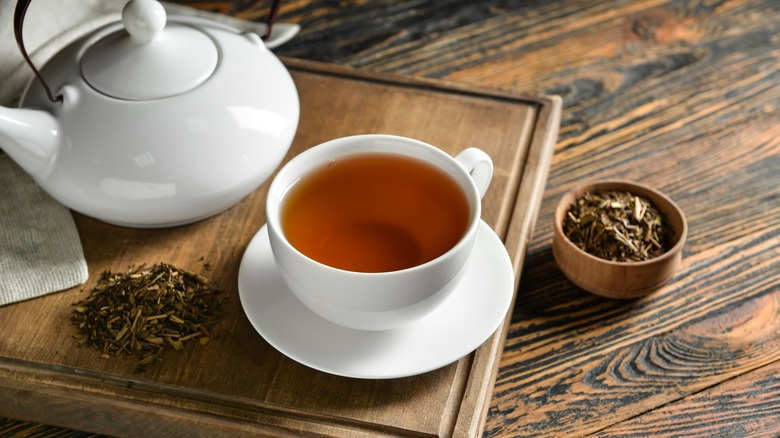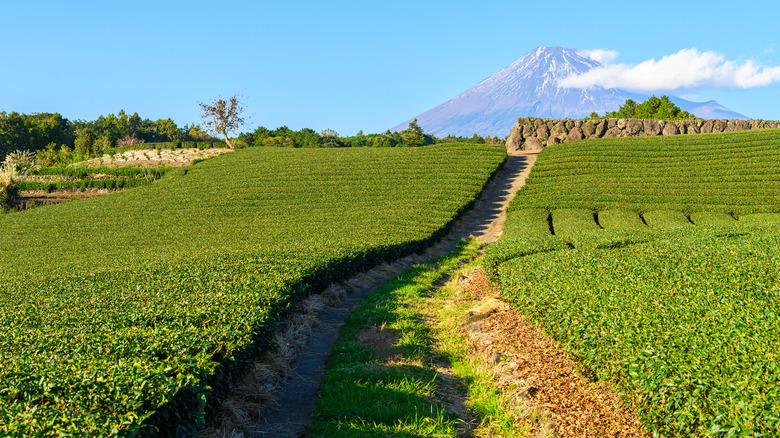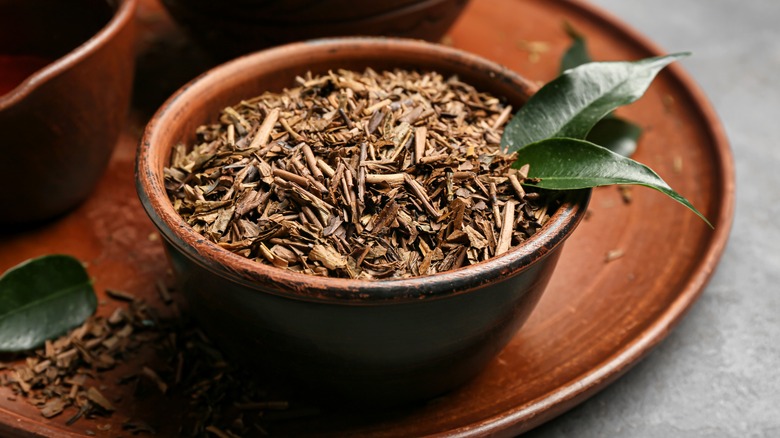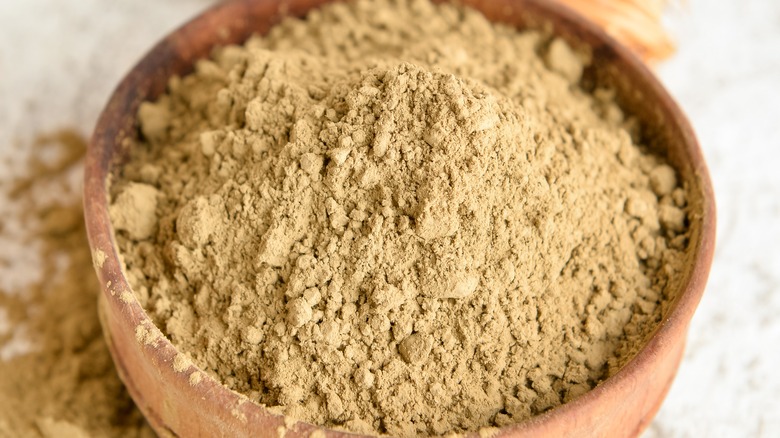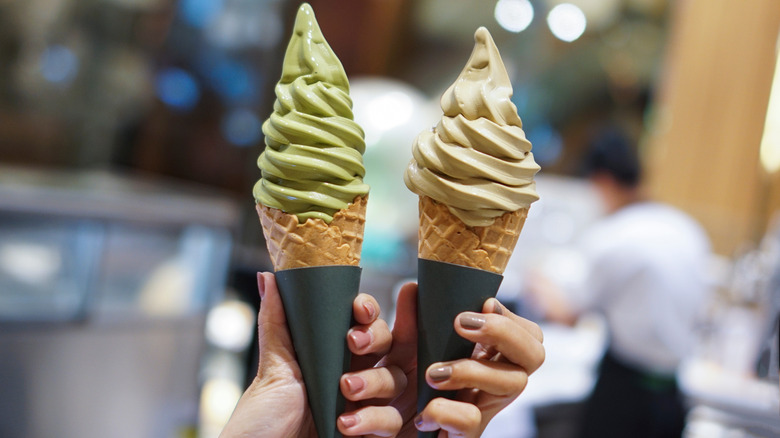What Makes Hojicha Green Tea Unique
Green tea has a long history in Japanese culture. During the Nara period in the eighth century, Buddhist monks brought it home from China, believing it helped them meditate better (via Hojicha Co). When word spread that green tea was good for the body and mind, both royals and working-class people alike began drinking it on a regular basis. Now, several centuries later, the steeped beverage is enjoyed worldwide in various forms. From matcha and sencha to gyokuro and genmaicha (per Michelin Guide), each type offers its own unique flavor and aroma — and hojicha is no different.
This particular green tea is special in many ways — from how it's made to how it tastes and the benefits it provides. Like matcha, hojicha is often used to flavor drinks, lattes, and desserts; its toasted, nutty, and caramel flavor gently lends itself to many recipes. With much less caffeine than other green teas, hojicha may just be the perfect cozy indulgence you need to get you through the day.
How is hojicha made?
Navdeep Kaur, the director of education at tea company Dona, told Thrillist that hojicha is processed in a particular way. It's commonly produced by steaming and roasting the leaves, stems, and twigs of the green tea plant (per Naoki Matcha). Depending on the composition of these different parts, one kind of hojicha tea will taste different from another, but in general, any version will have the drink's trademark roasted flavor and red-brown color. Kaur adds that the beverage leaves an aftertaste of caramel and chocolate on the palate.
The origins of the tea can be traced all the way back to the Meiji period, which took place from around the mid-19th century to the early 20th century (via Hojicha Co). At the time, the modernization of Japan was at the forefront of the emperor's plans, leading to new trade policies that boosted the country's green tea exports to new heights. The skyrocketing demand made it necessary for the tedious task of harvesting tea leaves by hand, one by one, to end. The tea trade underwent industrialization, using machines to harvest in bulk; however, this mass production resulted in other plant parts being gathered along with the leaves. The process created a lot of waste — which, in Japanese culture, is important to reduce.
To remedy this, one tea merchant in the 1920s decided to roast the debris on charcoal and then brew it, creating a warm and smoky green tea now known as hojicha.
The nutritional benefits of hojicha
Another unique aspect of hojicha is its benefits. It's common knowledge that green tea is such a powerful superfood with a bounty of healthy properties, including cancer-fighting, anti-inflammatory, and metabolism-boosting compounds as well as relaxing L-theanine (via Healthline) — all of which are also present in hojicha, per Senbird Tea. But this type also has some qualities that aren't typically found in other green teas.
For one, the roasting process for hojicha significantly reduces its caffeine content (via Hojicha Co). With just around 8 mg of caffeine per cup, this tea is a great option if you want to enjoy a warm beverage in the evening or simply cut back on the amount of caffeine you consume. The roasting process also leads the tea to have a soothing aroma, thanks to a natural compound called pyrazine that forms when amino acids and saccharides in the tea plant parts are heated up, according to Liliku Tea, a tea brand based in Tokyo. Pyrazine is known to induce a sense of relaxation and is also found in coffee, which is why the smell of your morning cup of joe makes you feel good. The combination of this compound, calming L-theanine, low caffeine content, and toasty flavors makes hojicha the ideal cozy time tea.
How to cook with hojicha
The best temperature for brewing other green teas is not necessarily ideal for hojicha, due to the fact that it's a roasted tea (via Hojicha Co). It should be steeped at a higher temperature, but since it tends to be more delicate, boiling water should be avoided. Instead, to achieve optimal sweet, smoky flavors without any bitterness, steep the tea in water (filtered is best) at 175 degrees Fahrenheit. If you don't have a temperature-controlled kettle, you can just boil water and wait for it to cool. It's also best to allow hojicha to cool off before taking a sip — not only to avoid a burnt tongue but also to ensure the tea's deeper, sweeter notes come out.
When baking with hojicha, Amy Hsiao, the founder of Brooklyn dessert bar Kitsby, recommends using it in powder form, preferably a dark roasted one, to ensure the flavor and color of the tea come out in the treats you make (per Thrillist). If you're not able to find hojicha powder, Hsiao has an easy suggestion — make your own by crushing up hojicha leaves in a coffee grinder. It's perfect to use in beverages and all kinds of desserts — from cookies to brownies, cakes, ice creams, and really any recipe that includes a good amount of fat. Candice Ng, the general manager at San Francisco's Stonemill Matcha, told Food52 that the fat from ingredients like butter or cream helps coat the graininess of hojicha powder.
Where to buy hojicha
Hojicha green tea is sold in many varieties across Japan, per Hojicha Co. Similarly, products flavored with the tea can be found in stores all over the country. However, the United States has only recently caught wind of the roasted tea, so, unlike the more widely popular matcha, it might not be as easy to find outside of dedicated tea shops, cafes, and dessert spots, such as Hsiao's Kitsby and U Dessert Story in San Francisco, where you can enjoy pies, lattes, and other goodies infused with hojicha flavors.
For now, it's more likely you'll need to make your own hojicha tea and desserts at home — and all the power to you for it. You can get the roasted tea from specialty retailers such as Dona, which sells a loose-leaf variety grown in Assam, India, or Stonemill Matcha, which offers hojicha powder sourced from Kyoto, Japan. You can also find many other brands on Amazon or browse tea shops in your area.
